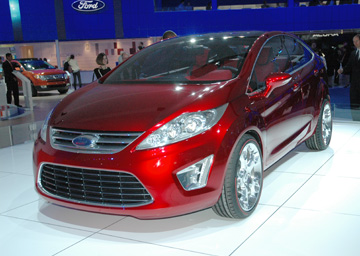
DETROIT – The Internet has made it tougher to design a small car for today’s customers, says Ford Motor Co.’s top designer.
The widespread availability of information over the Internet and increased globalization of the auto industry has led to a more discerning eye among consumers, heightening expectations even for the smallest cars, says J Mays, group vice president and chief creative officer.
“Everybody is connected up to the same information, and because of that expectations of design are global,” he says.
Ford, which displayed two versions of its Verve small car at the recent Detroit auto show, is preparing to enter the growing B-car market in the U.S. with a 4-door sedan version of the car slated in 2010. A Verve 3-door will debut in Europe later this year.
Small cars no longer equate to “cheap,” Mays says. In fact, it’s quite the opposite. “(Consumers) know what the best is out there, and they’re not prepared to accept anything less than that.”
As a result, the U.S.-market Verve won’t be an entry-level “econobox,” Mays says, because customers now are buying small cars based on “style, not just price.”
Ford has yet to reveal price targets for the production Verve, but reports indicate the car will be positioned below the Focus.

The dilemma facing all auto makers that have or plan a B-car entry in the U.S. is how to balance profitability and quality.
One solution is sourcing the vehicle from a low-cost country. Ford has made China one of the global production hubs for its B-car.
Design also plays an integral role, because the interior can be a key “differentiator” for small cars, Mays says. Attractive interior shapes, even when crafted from inexpensive materials, create “perceived quality,” he says, noting a well-executed design “doesn’t cost you anything.”
Material selection and craftsmanship – how components “interface with each other” – also are critical.
Meanwhile, Mays says Ford’s upcoming ’09 Flex cross/utility vehicle is a “10-year car.”
About “every 10 years somebody comes up with a (design) where people say, ‘Wow,’ (and) that reflects someone’s best effort at defining a particular segment,” he says.
Polarizing designs such as the Flex are more difficult for competitors to copy, he notes. “It’s like the second guy to fly across the Atlantic solo, nobody remembers his name.”
As Ford and its domestic competitors close the quality gap with their Asian counterparts, design will become increasingly important, Mays says.
While few would argue Asian auto makers are the ones to beat in quality, they still have a long way to go in design, he says.
“They sell their cars on reliability, dependability. As those things (achieve) parity with everyone else, they’re going to have to sooner or later create good design, or else,” he says. Ford-controlled Mazda Motor Corp. is the only Japanese maker with some “semblance” of a design language, he adds.
Among competitors, Mays says Audi AG is on track and “delivering the most clear-cut, compelling design language” of any German luxury maker.
Mercedes-Benz is “off track,” while BMW AG remains slightly off-kilter, even though its cars are becoming “less ugly,” Mays says.



